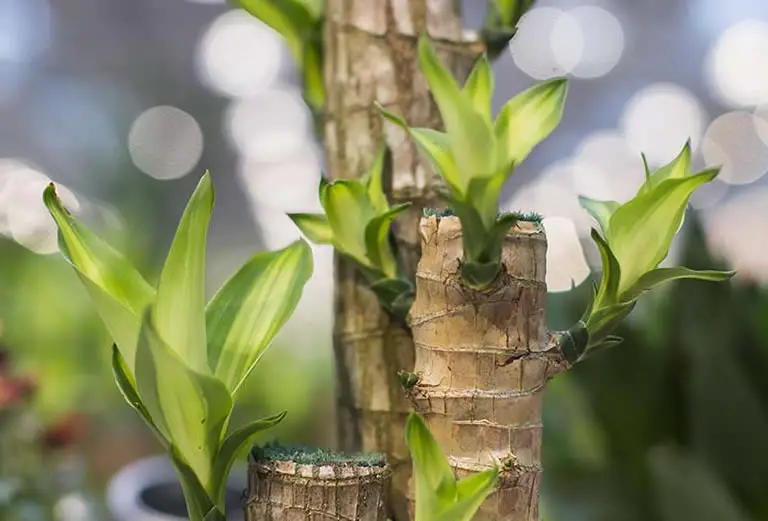Dracaena is a popular succulent houseplant that has about 120 different species. Although an easy-care plant dracaena owners sometimes encounter problems with foliage loss, usually due to an incorrect care routine. So, in this article I look at the causes for leaf loss on dracaena and ways to revive the plant and encourage new leaf growth.
Table of Contents
- Why The Leaves Are Falling Off Your Dracaena
- How To Bring Your Dracaena Back To Life
- How Dracaena grow new leaves & how to use that knowledge to revive your plant
- How to stimulate regrowth of leaves on a dracaena
- Fix incorrect temperature & prevent temperature fluctuations around the plant
- Fix incorrect light conditions
- Fix the damage done to the roots by incorrect watering
- Fix the damage done by overfertilization
- Eliminate disease & protect the plant against future outbreaks
- Eliminate pests & protect against possible future infestations
- Stimulating dracaena marginata leaves to grow back
- When You Can Expect Dracaena Leaf Regrowth
Why The Leaves Are Falling Off Your Dracaena
When a dracaena has foliage problems the cause almost always lies in the care routine of the plant.
Although there can be some causes for leaf loss that are beyond the plant owners control, such as pest infestation for example, in the majority of cases foliage problems are due entirely to an incorrect care routine.
This is actually fairly good news. It means an immediate positive and correct change in the care you are giving your dracaena will often lead to a speedy recover of the plant.
Let’s look at the six causes behind a dracaena shedding leaves before moving on to the cures.
6 causes of leaf loss on dracaena
Let’s quickly look at why your plant may be losing its leaves so that you can positively identify the cause behind your plant’s foliage woes.
The 6 potential reasons why the leaves are falling off your dracaena:
- Incorrect temperature/temperature fluctuations.
- Incorrect light.
- Incorrect watering.
- Overfertilization.
- Disease.
- Pests.
Dracaena are easy-care plants but they must receive the correct care or the plant will suffer.
Easy-care does not mean the plant can get along with any type of care routine at all.
It just means the plant will grow well with very little attention from you – as long as the care it is receiving is correct!
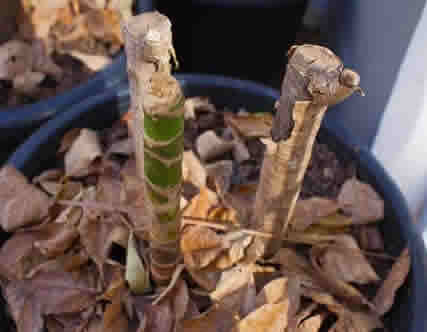
In all my years tending to houseplants I have found that in almost all cases the loss of leaves on a dracaena plant is down to a poor care routine.
Saving a dracaena with no leaves is possible
What if your dracaena has an issue that has caused it to lose all its foliage … can you save a dracaena with no leaves?
In most cases you can revive a dracaena with no leaves. As an evergreen succulent dracaena should always have some leaves.
So if the plant has lost all its foliage this is a sign of a serious underlying problem which you must investigate immediately.
Even with serious issues, immediate action can often lead to saving the plant.
Obviously to save a dracaena that has no leaves you must understand which problem is causing the issue.
And, you must act quickly as some issues could lead to the dracaena dying.
Can a Dracaena be revived?
A dracaena can be revived in most cases with the correct treatment and aftercare.
Even a dracaena suffering from a serious condition, such as root rot, can be revived if action is taken quickly and the correct treatment is administered.
So, it is of paramount importance that you take swift action when you notice a dracaena losing foliage.
The first step to identify the cause so that you can administer the correct solution.
How do you do that?
How To Bring Your Dracaena Back To Life
Below I give you instructions for nurturing your dracaena back to full life.
I show you exactly how to go about the plant’s aftercare to ensure a swift recovery and no recurrence of the problem.
Before I do that though I will give you a quick overview of how dracaena leaves actually grow. We know this you will be able to tell when your plant starts the recovery process.
How Dracaena grow new leaves & how to use that knowledge to revive your plant
As I pointed out in the article how to make lemon lime dracaena bushier this succulent is a slow grower.
It can take several years before a dracaena plant matures enough to bloom, with some species taking 10 years before they grow to their tallest height.
To grow new leaves a dracaena must be potted in the correct type of soil.
It must get at least 4 hours of strong indirect light per day.
It must only be watered when the top layer of soil dries out.
It should be given a half-strength fertilizer no more than every 3 weeks and only during growing season.
To grow property a dracaena must be potted in the correct type of light. This is a paramount.
Make sure the soil you use for dracaena is light and airy.
Review the information in our article about dracaena not growing for details about the ideal soil mix.
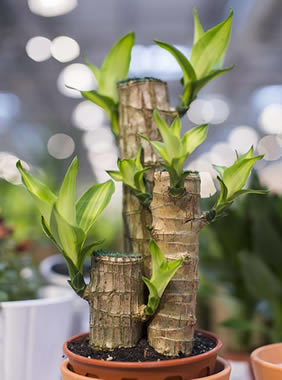
Make sure the dracaena gets at least 4 hours of good strong indirect light per day.
I personally give my plants at least 6 hours of indirect light per day sometimes opting to use a grow light when conditions are dim.
Make sure your watering routine is correct as underwatering and overwatering the plant will lead to foliage loss, as I will outline in more detail later.
Lastly, to encourage new leaf growth you should fertilize your dracaena every 3 weeks – during growing season only!
Always make up the fertilizer to half the strength recommended on the product label or you will overfertilize the plant.
Will the leaves grow back on my dracaena?
The leaves will only grow back on your dracaena if the plant is healthy.
The above information only applies to a healthy dracaena plant.
If your plant was perfectly fine but has recently started to lose leaves then you must identify the problem and treat the plant appropriately.
Let’s look at how to do that now.
How to stimulate regrowth of leaves on a dracaena
When a healthy dracaena starts to shed foliage this is a sign of a problem. How do you regrow dracaena leaves?
To regrow dracaena leaves you must first identify which of the 6 potential causes is creating the problem.
Each cause has a different fix that must be implemented for the plant to recover and start developing new leaves.
When you discover the cause of the foliage loss it then becomes a simple matter of treating the plant for the specific problem.
As long as the leaf loss is not due to one of the more serious issues, such as root rot, the plant will start to recover quite quickly.
Be aware though that growth is normally slow in dracaena, so it may take some time for the plant to regain its full former glory.
Let’s now look at the 6 causes for a dracaena losing its leaves and the actions you must take to fix each problem.
Fix incorrect temperature & prevent temperature fluctuations around the plant
Dracaena are tropical succulents that prefer warm, humid air. Their ideal temperature falls in the range of 65°F – 75°F.
As the average home is kept at a fairly consistent 70°F, this makes dracaena a perfect houseplant.
Although household temperatures can often dip below 65°F, on winter nights for example, this is not enough to cause foliage loss on a dracaena.
However, if the temperatures stay cold is over prolonged periods of several days or more it can cause leaf loss.
For most dracaena even a short-term dip to about 50°F will have no long term negative effect on the plant.
Temperatures lower than this will cause problems and likely end if leaf shedding.
Temperatures over 90°F will cause problems with the foliage.
Dracaena will start to shed leaves when it is subjected to very high temperatures over a prolonged period of time.
However, very low and very high temperatures are less likely to cause leaf loss on a dracaena.
It is fluctuating temperatures that are much more likely to be the cause.
Sudden and dramatic dips or rises in temperature can shock a dracaena enough to cause leaf loss.
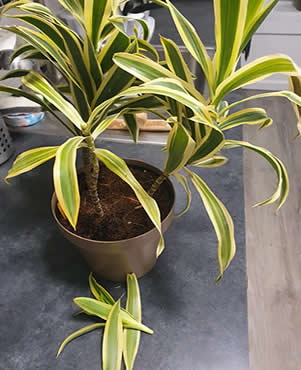
Placing the plant beside doors that open to the outside of the house, or beside drafty windows, can cause sudden dips in temperature.
Likewise, placing the plant beside a refrigerator or freezer door can have the same effect.
On the flip side, placing a dracaena close to an air vent or radiator will subject it to sudden rises in temperature which can also lead to leaf loss.
It is best to place your plant in an area of your home that gets consistent temperatures.
Also keep it away from anything that may cause sudden rises or dips in temperature, such as refrigerator doors opening and closing nearby or heaters and radiators blasting warm air.
Although dracaena does require higher than normal household humidity levels, best provided by a cheap humidifier, lower humidity levels are very unlikely to lead to leaf loss.
Fix incorrect light conditions
Dracaena, like all plants, require light for photosynthesis.
Although dracaena can grow in low light conditions, these conditions are not ideal.
If dracaena does not get enough light it will shed leaves in order to reserve its limited resources.
So, you must ensure this succulent gets enough light per day to keep it growing steadily.
The plant requires a minimum of 4 hours of direct light per day.
However, I personally give my dracaena a minimum of 6 hours of indirect light per day as I find they thrive and bloom better.
Bear in mind that giving a dracaena direct sunlight is just as bad as giving the plant no light at all.
Keep your dracaena away from locations that get very strong direct sunlight.
Direct sunlight will burn the leaves and the plant might start shedding foliage.
See our dracaena light requirements guide.
Fix the damage done to the roots by incorrect watering
An incorrect watering routine will often cause a dracaena to shed leaves.
This is due to dehydration.
Both underwatering the plant and overwatering it lead to dehydration.
This may sound counterintuitive but the symptoms of overwatering and underwatering are very similar.
It is obvious why underwatering a dracaena leads to dehydration but why does overwatering lead to the same problem?
Overwatering will almost always lead to root rot.
Root rot prevents the plant’s roots from absorbing moisture in the soil, thus making them unable to distribute water to the rest of the plant. The plant then dehydrates.
This is such a serious problem that we have an entire article dedicated to it.
So, to identify and treat this very serious problem read our article on dracaena root rot.
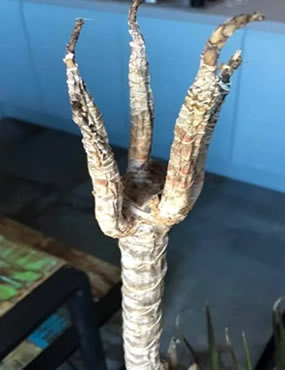
*Note: Something you need to be aware of is that using the wrong type of soil with dracaena can lead to water retention which has the same effect as overwatering.
So, you may have your watering routine correct but because the plant has been potting in an incorrect growing medium, that promotes water retention, the dracaena suffers from root rot.
You must therefore make sure that you are using the correct soil as outlined in the above mentioned article.
How can you tell if the watering routine for your dracaena is incorrect and is the cause of its foliage loss?
You must look for signs of dehydration.
The first signs of dehydration will be the dracaena drooping when its leaves begin to sag.
There will also be evidence in the lower parts of the stems. They may appear darkened and even mushy or weak.
If you identify any signs of dehydration in your plant you must take immediate action.
Read the aforementioned article about root rot in dracaena and follow the steps it outlined.
That article will let you easily identify if you have an underwatered or overwatered dracaena.
Fix the damage done by overfertilization
Just as overwatering can cause root rot in a dracaena so too can overfertilization.
See the above section for a link to an article on identifying and treating root rot in dracaena.
Although you can fertilize dracaena regularly during its growth cycle you must never give it full strength feed.
This is a mistake many dracaena plant owners make.
A dracaena can only handle half strength fertilizer or it will be saturated with nutrients.
Additionally, the soluble slats in the feed will attack the roots and cause root rot.
If you have been overfertilizing your plant then you must take the action outlined in the article on root rot.
If the plant does not have root rot then you can simply wash the fertilizer out of the soil by heavily watering it and letting it drain (while the plant is out of its pot).
Or you can simply use fresh soil and repot the dracaena.
Eliminate disease & protect the plant against future outbreaks
The most common disease to affect dracaena is fungus. A fungal infection leads to root rot.
It should be treated as described in the article I mentioned in the previous section.
Other common dracaena diseases can usually be treated effectively with a good fungicide unless they have attacked the roots (when you will need to treat the plant for root rot).
Eliminate pests & protect against possible future infestations
A pest infestation is one cause of leaf loss in a dracaena that is not due to a poor care routine.
Common pests such as aphids and mealybugs will feast on the sap of dracaena leaves often leading to them falling off the plant, especially if the bugs feed at the stem.
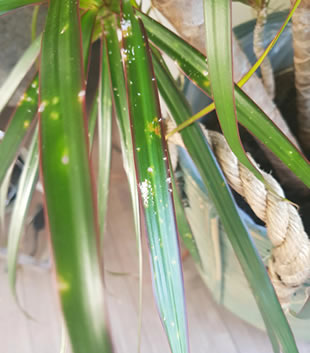
When you find pests on your dracaena you should treat the plant with a good quality organic pesticide.
If you spot a pest type that attacks the plant’s roots then you must treat the plant in the same manner I outlined for treating root rot above.
Do this after you use the pesticide to eliminate the pests that is.
Stimulating dracaena marginata leaves to grow back
Dracaena Marginata is one of the most popular types of dracaena houseplants and one that I am often asked about.
Dracaena Marginata leaves will grow back only if you identify the cause of the problem and give the plant the appropriate treatment.
Foliage issues on dracaena are always a sign of an underlying problem.
There are 6 potential causes for dracaena leaf loss and each has a different treatment.
The above sections of this article outline all 6 potential causes for the loss of leaves from a dracaena plant.
You should read those sections so you can determine the cause of the foliage loss on your dracaena marginata.
When You Can Expect Dracaena Leaf Regrowth
There should be signs that your dracaena is developing new leaves quite quickly after it has been successfully treated.
When will dracaena marginata leaves grow back after the plant loses all its foliage?
Although dracaena is a slow grower you should see signs that new leaves are starting to develop between 1 – 3 weeks after you administer the correct treatment to your ailing plant.
If the plant has been severely damaged then you may want to propagate a new plant. This involves take a cutting so you can grow a new dracaena plant from it.
Read our article how to root dracaena for details on how to do this but keep in mind that dracaena is poisonous and can seriously harm pets if they eat the foliage.
How to revive a Dracaena Marginata plant
The steps to revive and save a dying dracaena marginata plant are exactly the same steps you would take to help any other dracaena plant in the same situation (as outlined above).
But to recap if you have landed on this section only: if you have a dracaena marginata that is on the brink of death, how do you revive a Dracaena Marginata plant?
You revive a Dracaena Marginata plant by first identifying the cause of the problem and then administering the correct treatment.
There are a number of possible causes for an ailing dracaena each of which are easily identifiable and most of which are fixable.
Review the sections above so you can determine the exact cause of your dracaena marginata problems and identify the fix you must employ.

